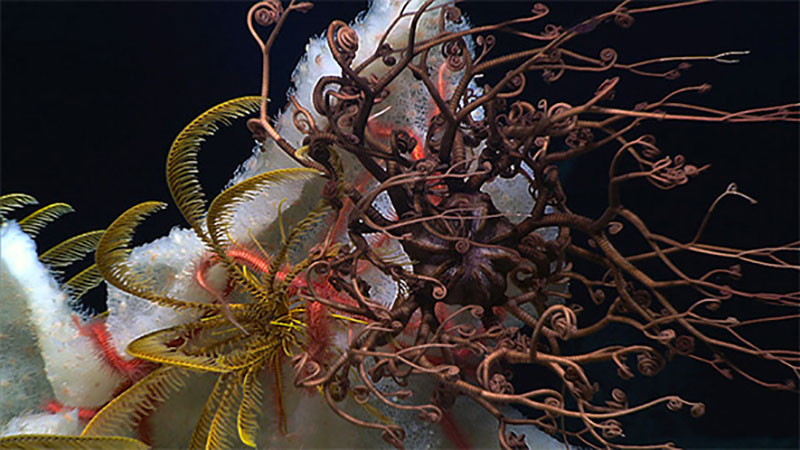

Map showing the completed 2015 operating areas (white lines), and planned operating areas (green lines) for the 2016 Campaign to Address Pacific monument Science, Technology and Ocean NEeds (CAPSTONE). Image courtesy of the NOAA Office of Ocean Exploration and Research. Download image (79 KB).
Following a transit from California to Hawaii, NOAA Ship Okeanos Explorer explorations for 2016 will begin on February 25, 2016, and include work in the marine environments in and around: Papahānaumokuākea Marine National Monument (PMNM); Oahu and the big island of Hawai’i; the area south and west of Molokai, Lana’i, and Kaho’olawe; the Wake Atoll portion of the Pacific Remote Islands Marine National Monument (PRIMNM), now known as Pacific Islands Heritage Marine National Monument; the Commonwealth of the Northern Marianas Islands (CNMI) and the Marianas Trench Marine National Monument (MTMNM); and the vessel transit areas between Honolulu, Hawai‘i; Guam; Saipan; and Kwajalein.
Many of the areas planned for exploration are already protected as marine monuments and national marine sanctuaries, however, protection is only the beginning of management efforts. These areas are protected because they are unique, biologically rich and diverse, and represent national symbols of ocean conservation.
During the first full exploration of this season, from February 25 - March 18, 2016, scientists will be continuing last year’s exploration of deep-water habitats in and around Papahānaumokuākea Marine National Monument (PMNM) and will include work on seamounts in the Mid-Pacific Mountains while en route to port in Kwajalein Atoll in the Marshall Islands.
During these expeditions, scientific focus will include:
Daily remotely operated vehicle (ROV) dives are planned as the ship transits to the northwestern portion of the PMNM. Seamounts, rift zone ridges, and other types of abrupt topography will be the primary focus due to the likelihood of these areas hosting extensive communities of deep-water corals and sponges, as well as manganese crust habitats at depths of 1,000 to 2,500 meters. Additionally, limited dives will be executed to search for ships lost during the World War II Battle of Midway.

Deep-sea corals and sponges provide habitat and refuge for many other animals living on or near the seafloor. Here, a sponge covered with hundreds to thousands of tiny anemones also provides a home to several brittlestars (pink), crinoids or “sea lilies” (yellow), and a basket star (brown). Image courtesy of the NOAA Office of Ocean Exploration and Research, 2015 Hohonu Moana. Download image (101 KB).
During this expedition, the exploration strategy of the Okeanos Explorer will be employed: bathymetric mapping using multibeam sonar; water column exploration using a Conductivity, Temperature and Depth Profiler (CTD); and remotely operated vehicle (ROV) imaging and video. Scientists from around the world will be participating in the explorations in real time through telepresence technology and students and the general public can watch and listen to ROV dives in real time on the NOAA Ocean Explorer website.
Even as the importance of deep areas of the ocean in our everyday lives continues to increase, our knowledge of these areas remains limited. NOAA's Office of Ocean Exploration and Research is providing scientists and resource managers with access to basic information about deep-sea habitats and life forms so that they can prioritize future management and research efforts. This multi-year project will highlight the uniqueness and importance of these marine protected areas, both locally and to the world.